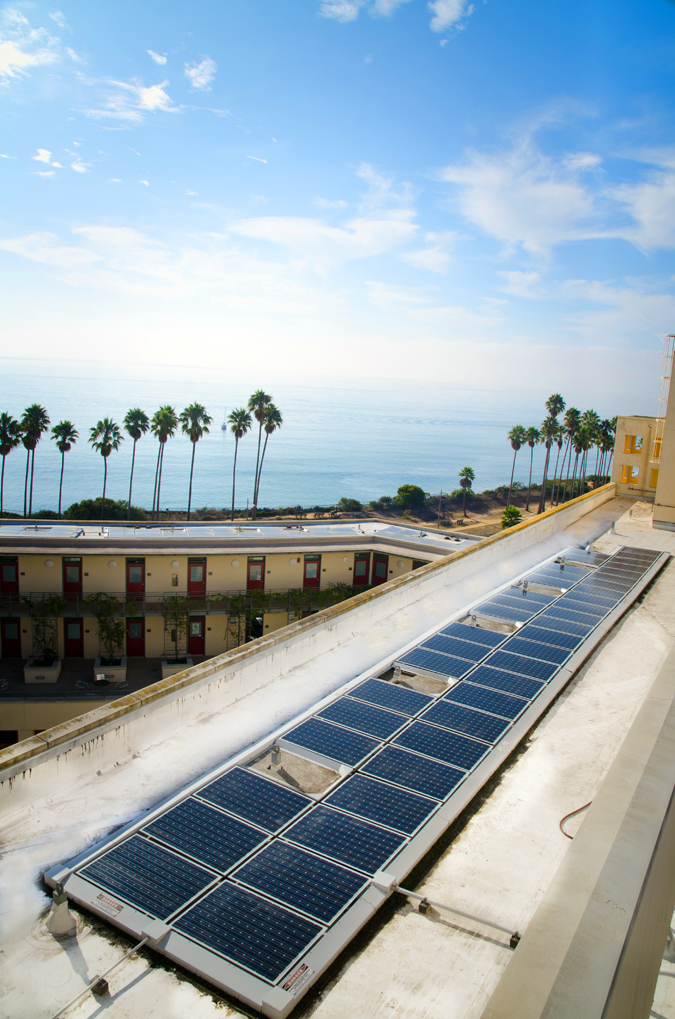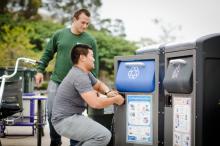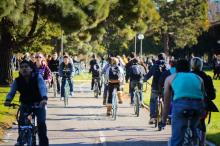
Sustainability Efforts Soar, Score at UC Santa Barbara


It's the premier document of its kind in the University of California system, and now UC Santa Barbara's recently unveiled water conservation plan has notched another first: a Best Practices Award from the 2013 California Higher Education Sustainability Conference.
The UCSB Water Action Plan bested its cross-UC competition for water efficiency and site water quality practices in the contest that typically lauds one UC and one CSU campus in each category. Santa Barbara was the only water section winner.
All the awardees, announced by the UC Office of the President, will be honored during the sustainability conference set for June 23–27. With the theme "Communicating Sustainability," the event this year will be hosted by UCSB –– the place where it all began. Registration will open in late April.
The now-annual gathering was born in 2002 out of Bren Hall, home to UCSB's Bren School of Environmental Science & Management. Some 100 guests from across the UC system were invited to tour Bren –– the nation's first-ever building to achieve a LEED "Double Platinum" sustainability rating –– and to talk best practices. Eleven years later, the conference is a 1,000-attendee, 90-institution affair, with representatives from UC, CSU, and California Community College campuses coming together to share ideas.
"All three systems are pushing each other now, because the conference has helped to fuel cross dialogue and motivation," said Katie Maynard, event manager for the conference, and sustainability coordinator in UCSB's geography department. "The breadth of topics is one of the things we're most proud of, and the fact that we get students, faculty, staff, and administration all at the same table.
"This year, with the idea of communicating sustainability, we want to reach out to broader communities and start thinking about how to get to the next stage," she added. "We're leaders now, and we're ready to go out there and share our story."
The story of sustainability at UCSB dates back decades, to the devastating 1969 oil spill off the Santa Barbara coast –– just below the campus cliffs, in fact –– that spurred formalization of UCSB's vibrant environmental studies program and inspired a never-ceasing drive for eco-leadership.
The campus had its first full-time sustainability position in the 1970's, Maynard said, and today is "leaps and bounds ahead" when it comes to academic involvement: 47 percent of UCSB's academic departments have at least one course related to sustainability, and 45 percent have at least one faculty member engaged in sustainability research.
"We just have had some really good people at different points of campus that made it all happen," said Mo Lovegreen, sustainability director at UCSB and one-time Bren School staffer who was a key organizer of the inaugural conference. "We have a gifted staff. People are just passionate about sustainability, and they want to make an impact. We're really lucky. It's exciting to think that we've made a difference. The goals we set with Bren Hall really made it and so did the conference."
From Bren to the recently approved, award-winning water action plan –– heralded as a "template" for its sister UC campuses to follow –– UCSB has long made a habit of setting the sustainability bar.
A few additional highlights:
• UCSB began working with the U.S. Green Building Council in the pilot version of LEED New Construction in 1998 and to date has achieved 43 LEED certifications for its buildings, including Bren Hall. The campus was the first in the UC system to successfully complete a LEED for Homes project.
• Adopted and unveiled on the eve of Earth Day in 2008, UCSB's Campus Sustainability Plan –– a comprehensive road map with a 20-year trajectory –– was then the first of its kind in the UC system, Lovegreen said. It is being refreshed for 2013.
• All of UCSB's dining commons have been certified as green businesses by the Santa Barbara Green Business Council. In 2012, the campus won a Best Practices Award in sustainable food service for its Root 217 Café, which features local, organic foods, and uses almost exclusively compostable products.
• UCSB was the first campus to introduce a quarterly "green fee" for students, annually generating more than $150,000 for The Green Initiative Fund (TGIF), a grant program that aims to reduce environmental impacts. TGIF has since been enacted at multiple UC campuses.
The campus's sustainability activities today reach well beyond its 93106 ZIP code. Working with local cities, the county, and the Community Environmental Council, UCSB in 2011 launched the Central Coast Sustainability Summit. The same event in 2012 gave rise to another new effort: the Multi-jurisdictional Renewable Energy Taskforce, a planning and strategizing entity that enables cross-agency communication and collaboration on renewable energy projects with the potential to benefit Santa Barbara County at large.
The taskforce endeavor is an important step in bolstering the region's commitment to environmental sustainability and increasing its deployment of renewable energy. It will also serve to fortify the cooperative bonds between UCSB and other green-engaged agencies across the county.
It's all part and parcel of an environmental ethos that abounds at UCSB, according to Bruce Tiffney, dean of UCSB's College of Creative Studies and co-chair of the Chancellor's Sustainability Committee.
"We are doing great things," Tiffney continued. "The staff have been doing tremendous things quietly, in the interest of sustainability, and also just in the interest of economy. We've tried to figure out how to be more energy efficient from a purely monetary standard, and I think we've made enormous leaps and bounds. One of the things that continually startles me, and is still argued on the national scale, is that we can't afford to do this. In a very real sense, no, we can't afford not to do this."
† Middle image: The solar-powered recycling and refuse compactors known as BigBelly reside in multiple locations across campus. UCSB will soon become the first institution in the U.S. to use BigBelly units for composting.
Credit: Jonas Krant
Related Links
UCSB Sustainability
California Higher Education Sustainability Conference



